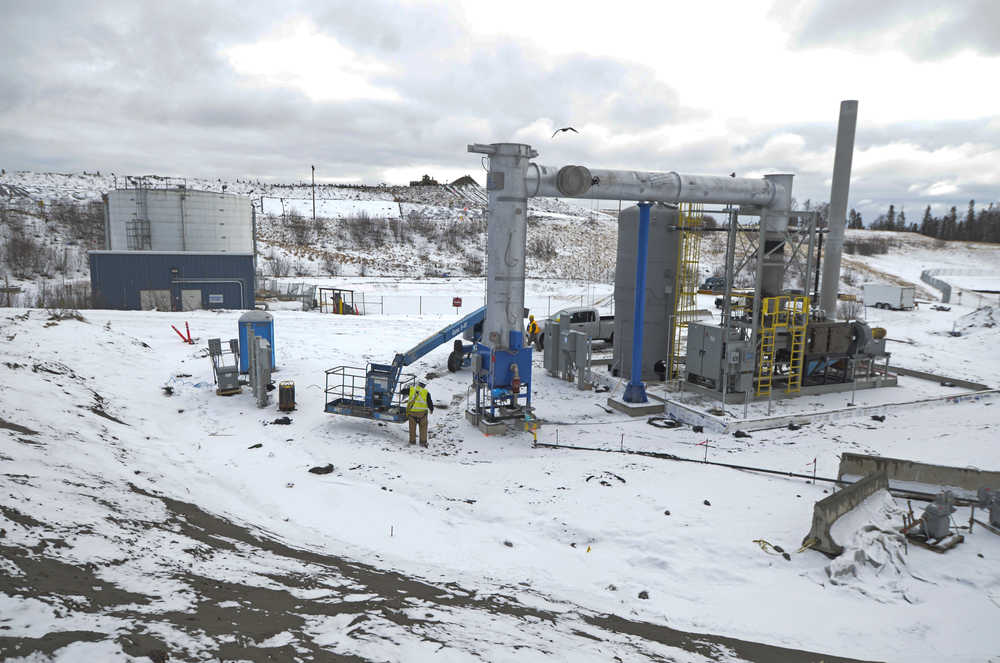A few changes proposed for the Central Peninsula Landfill will not only make it bigger but possibly provide a way to harness its gas that’s currently going into the atmosphere.
The landfill just south of Soldotna handles approximately 98 percent of the Kenai Peninsula Borough population’s trash. When the trash is dropped off there, it’s placed into a lined cell to be covered. The landfill has been using lined cells since 2006; one has already been filled and the second is likely to be full by 2019.
Planning for the excavation of the third cell has begun, and the Kenai Peninsula Borough Assembly approved an appropriation of $400,000 from the Solid Waste Capital Improvements Fund on Tuesday for the project. A lined cell uses a pad of clay, plastic or composite at the bottom and sides of the cell, preventing the waste from leaching into the environment.
The $400,000 won’t cover the cost to prep the landfill for the next decade, though. The administration plans to bring an ordinance before the assembly in May requesting the issuance of $10.6 million in general obligation bonds to be placed as a proposition on the Oct. 4, 2016 general election. The bonds would fund the construction of two additional cells and equipment for the landfill, according to a memo submitted to the assembly at its Tuesday meeting.
The cost of the materials Central Peninsula Landfill uses to line its cells is significant and adds up the cost of the project, plus the cost of design by a professional engineer and actual labor, said Jack Maryott, director of the borough’s Solid Waste Department.
The borough requests enough in each bond issuance for the landfill for two cells to be built at once, Maryott said. He said the cells are designed to operate for five years each and are scaled for growth in demand.
“We size them accordingly,” Maryott said. “There’s consideration for the growth of the peninsula. We would expect that in ten years the population will be bigger.”
The borough’s Solid Waste Department also plans to look into a gas utilization program at the landfill. Buried waste generates leachate when it encounters liquid, usually rainwater, which is currently collected into leachate storage tanks, recirculated back through the waste to accelerate decomposition and evaporated off through a leachate evaporator kept on site. Through a gas utilization program, the gas could be harvested and used as energy with the installation of infrastructure to convert the gas into usable energy such as electricity or heating.
The borough assembly awarded a contract to conduct a feasibility study on the project to CH2M Hill, an Englewood, Colorado-based engineering firm. The study will identify possible uses for the methane gas and is estimated to be finished by June 30, Maryott said.
Right now, the landfill is venting the gas into the atmosphere through an evaporator. Eventually, the landfill will have emitted enough gas that the borough will have to manage it by regulation, so the landfill gas utilization study may provide an alternative use for it, he said.
“Why not capture some of that gas and use it?” Maryott said. “There’s lots of different uses for it. The direct use would be running the evaporator. Some uses are heating buildings, boilers. They may be looking at heating Skyview (Middle School), things like that.”
The Municipality of Anchorage has a similar project that converts its landfill gas to energy through which it delivers electricity to the Fort Richardson side of Joint Base Elmendorf-Richardson.
The gas it produces is sold to Doyon Utilities, which was a partner on the construction of the project, according to a project summary from the Solid Waste Association of North America.
Right now, the project for the borough is just to look at the best use for the gas being produced, Maryott said.
“We’re going to have to do something with it at some point, and that point is about 15 years off,” Maryott said. “Why not manage some of it now (with infrastructure), if you can manage some of the savings?”
Reach Elizabeth Earl at elizabeth.earl@peninsulaclarion.com.

